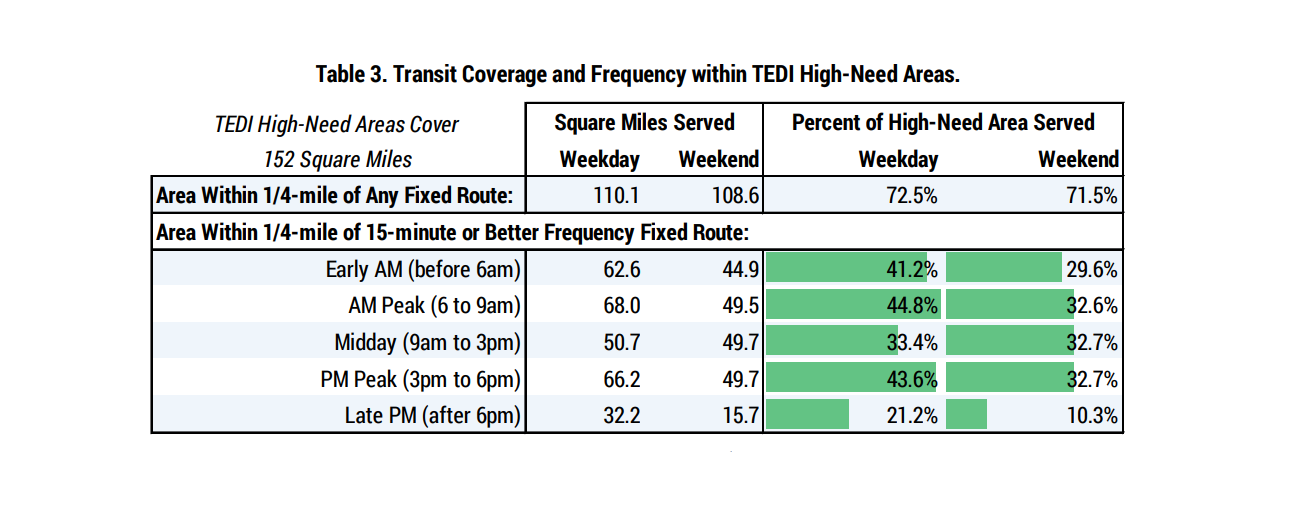
Share On Social!
Every segment of American society—individuals, families, communities, and businesses—benefits from public transit.
However, there is a lack of equity in these services. Latinos, for example, often report bus routes are unreliable, infrequent, or even unsafe, contributing to disparities in health and wealth, according to a Salud America! Research Review.
An equitable transit network for Latino and all families starts with an equity analysis.
That’s why transportation advocacy group, LINK Houston, conducted its Equity in Transit 2018 Report.
They found that nearly one million residents in Houston, Texas (44.5% Latino) are living in areas with high-transit needs, but do not have access to frequent weekday, weekend, and evening services.
Do you know who has access to frequent service in your community?
Equity in Transit
A few years ago, the Houston Endowment recognized that although they were investing in great groups that provided great services, residents weren’t able to get to them. That led to a comprehensive strategic planning process and, ultimately, the formation of LINK Houston.
 The group advocates for a robust and equitable transportation network so that all people can reach opportunity.
The group advocates for a robust and equitable transportation network so that all people can reach opportunity.
Equity in Houston means ensuring that quality, frequent, and available transit is provided within communities where residents need it most, both for trips within their communities and trips to opportunities elsewhere in Houston (work, education, health care, shopping, etc.).
Although there are nine public transit operators in the Greater Houston Area, the Harris County Metropolitan Transit Authority (METRO) is the primary provider of regularly scheduled fixed route transit in the region’s core, thus the focus of ridership analysis and service recommendations provided in the report.
Transportation Equity Demand Index
To explore transit equity, LINK Houston developed a Transportation Equity Demand Index (TEDI) by combining 15 indicators of demographic, economic, and built-environment conditions.

They identified block groups with high-need and identified statistically significant concentrations of need, known as high-need areas.
They found:
- TEDI high-need areas account for just 8% of land area but 23% of population, 22% of the workforce, and 24% of households
- TEDI high-need areas have twice the rate of poverty (24% of households are in poverty)
- TEDI high-need areas have nearly three times the rate of zero vehicle households (12%)
- TEDI high-need areas have commuters are 2.5x more likely to already be using transit to access work
- Density is more than three times higher than all other areas, although there are pockets of density elsewhere
Finally, they analyzed transit service coverage in TEDI high-need areas.
Inequitable Transit Service in Houston
People living high-need areas lack access to frequent transit service, particularly on evenings and weekends.
Overall, about 72% of residents in high-need areas are within a fourth-mile of transit, according to the report.
However, looking at frequent service on evenings and weekends, availability and utility plummet.
“Access to frequent transit options in the evening matters to TEDI high-need areas, as these areas represent higher concentrations of hourly workers, who may be working jobs outside of the daytime hours, as well as areas where there are higher concentrations of all-purpose riders, using transit for a variety of reasons in addition to work trips,” the report states.

On weekdays, frequent transit covers about 40% of TEDI high-need areas, but only 21.2% after 6:00 pm.
On weekends, frequent transit covers about 30% of TEDI high-need areas, but only 10.3% after 6:00 pm.
The creation of TEDI enables LINK Houston and partners to help METRO and its stakeholder partners to more effectively meet two main public policy priorities: provide transit service to those who need it most and provide stakeholders with information needed to direct resources toward needs.
Recommendations
Improving public transportation can improve Latino quality of life.
In their report, LINK Houston recommends specific operational changes to frequency, span of service hours, reliability, and accessibility.
Frequency:
- Update 8 local bus routes so that the entire frequent network comes at least every 15 minutes all day, every day.
- Expand the frequent network by converting 10 specific 30-minute routes to 15-minute frequency.
- Make local bus routes come at least every 30 minutes, eliminating 60-minute wait times for local buses.
- Increase the frequency of all rail lines at night so that trains come at least every 15 minutes after 9 p.m.
Span of service hours:
- Extend service hours on 12 local bus routes connecting under-resourced communities to extended-hour centers (i.e., the airports, Convention Center, Galleria/Uptown, higher education institutions, and the Texas Medical Center.)
Reliability:
- Perform 90% of local bus trips on time (up from a target and reality of 75%).
- Eliminate schedules for routes/lines operating every 8 minutes or faster (e.g., Route 82).
- Post real-time next arrival/departure at all transit centers, transfer points, and heavily used stops (i.e., the top 4 %of boarding and alighting locations would impact 49% of all transit activity).
- Confirm schedules and frequency posted at stops match the information available on METRO’s website and apps.
Accessibility:
- Fulfill commitments to universal accessibility so that stops are reachable regardless of age, size, or ability.
- Prioritize construction of bus stop amenities (i.e., shelters, seating, lighting, trash bins, etc.) where off-peak service frequency is 30 minutes or longer (because the longer you wait, the more you need a place to sit).
If you live in Houston, share this with leaders in your community to make the case for equitable investment in accessible and frequent transit service.
If you don’t live in Houston, share this with leaders in your community to make the case for an equity analysis to provide transit service to those who need it most.
Explore More:
Transportation & MobilityBy The Numbers
27
percent
of Latinos rely on public transit (compared to 14% of whites).




